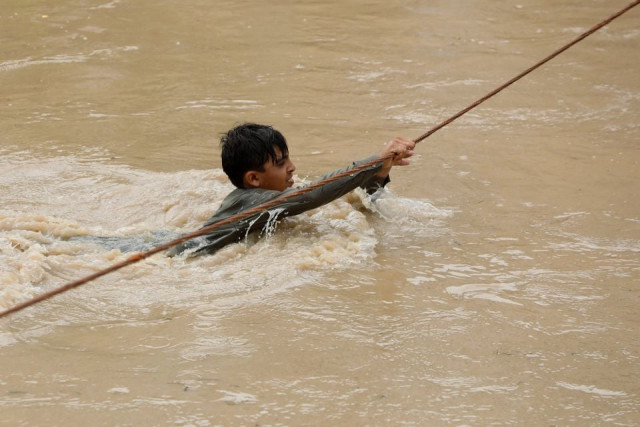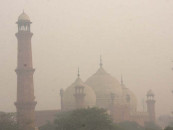Sindh braces for more misery
High-level flood warning issued at Indus River; Inhabitants asked to evacuate

As Sindh continues to reel under the worst floods in living memory for weeks, the province is bracing for a fresh deluge from swollen rivers in the north that have knocked down cellphone towers, bridges and power lines, severing communications for millions and forcing the evacuation of hundreds of thousands across the country.
The mighty Indus River that courses through the country’s second-most populous region is fed by dozens of mountain tributaries to the north, but many have burst their banks following record rains and glacier melt.
As those at the helm of rescue and relief operations winch up people stranded in floodwaters amid the rising death toll, officials have warned torrents of water are expected to reach Sindh in the next few days, adding misery to millions already affected by the floods.
"Right now, Indus is in high flood," said Aziz Soomro, the supervisor of a barrage that regulates the river's flow near Sukkur.
However, the raging waters are staring in the face of an ill-prepared infrastructure as the fate of hundreds of thousands of people in the flood-ravaged Sindh lies with a 90-year-old barrage that directs the flow of water from the mighty Indus River into one of the world's largest irrigation systems.
Water is redirected by the barrage to a series of canals totalling nearly 10,000 kilometres that thread through farmlands, but years of neglect mean they are not capable of dealing with today's record volumes.
Read: Death toll breaches 1,030 mark as floods wreak havoc
Water from the Indus is already lapping over its banks in several places, and unless the Sukkur Barrage can control the flow, catastrophe will result.
Meanwhile, the Flood Forecasting Division (FFD) also issued a high-level flood warning in the Indus River at Taunsa Barrage and Chashma Barrage, located in Punjab.
The water levels in rivers and dams across the country are reaching a dangerous rise with the Kabul River experiencing a high flood as well.The FFD further issued directives for the inhabitants to evacuate the area and move to safer regions.
The Indus River System Authority (IRSA) too has issued a warning of a high level of flood in the Indus River at Taunsa Barrage and Sukkur Barrage. As per the authority, the inflow of water at Taunsa Barrage is 515,000 cusecs while at the Sukkur Barrage, it is 562,000 cusecs.
In a statement, the IRSA said that there was a medium level of flood at Chashma Barrage where the flow of water is 461,000 cusecs, whereas at Nowshera, Khyber-Pakhtunkwa, it is at 305,000 cusecs.It was further reported that the inflow of water at Tarbela in the Indus River is 311,000 cusecs, at Mangla Dam in Jhelum it is 53,000 cusecs and at Kala Bagh, it is 425,000 cusecs. Moreover, at Marala in the Chenab River, the flow is 66,000 cusecs, at Guddu Barrage, it is 485,000 cusecs and at Kotri Barrage, it is 334,000.
Death toll breaches 1,030 mark
As floods continued to devastate the country on Sunday, particularly the provinces of Khyber Pakhtunkhwa (K-P) and Balochistan leaving at least 119 people dead and more than 70 injured in the past 24 hours.
Floods have claimed over 1,030 lives, with 74 deaths reported in Sindh, 31 in K-P, six in Gilgit-Baltistan (G-B), four in Balochistan, and one in Punjab and Azad Jammu and Kashmir (AJK).
According to the data released by the National Disaster Management Authority (NDMA), 32 children, 56 men and nine women are among those who died in the flood after the rains, while the number of victims has reached 5.77 million.
Over the past 24 hours, nearly 0.95 million houses and 0.72 million livestock were flooded while 0.27 million houses were destroyed and 3,116 kilometres of highways and 149 bridges were washed away.
According to sources, 0.49 million people in Sindh, 0.45 million in Punjab, and 0.36 million in Balochistan have been affected by floods.
Read: Waterborne diseases may kill more people than floods in Pakistan
On the appeal of Prime Minister Shehbaz Sharif, a plane carrying relief goods for the flood-affected people of Pakistan from the United Arab Emirates (UAE) has landed at Nur Khan Airbase in Rawalpindi.
The relief goods include tents, food items, medicines and other essential goods.
UAE Ambassador to Pakistan and Planning Minister Ahsan Iqbal received the relief goods at the airport.
It is pertinent to mention that 15 more planes carrying relief goods will reach Pakistan in the coming days on the instructions of UAE President Mohammed bin Zayed Al Nahyan.
Similarly, two ships carrying relief goods from Turkiye are expected to arrive in Karachi today. The Turkish Consul General in Karachi will hand over the relief goods to the Pakistani authorities at the airport tomorrow morning.
Meanwhile, the Pakistan Telecommunication Authority (PTA) announced that various private mobile network services had been restored in the provincial capital of Balochistan, while efforts were underway “to restore services in other affected areas”.
Earlier this week, as the unprecedented vicious attacks triggered by climate change, had continued unabated, leaving many marooned, the environmental crisis had robbed Balochistan of digital connectivity after almost cutting it off from the rest of the country physically.
Navy relief operations underway
Pakistan Navy’s humanitarian assistance and disaster relief operations are underway in flood-hit areas of Sindh.
The Navy’s spokesperson said on Sunday that its personnel rescued locals stranded inside flooded homes and shifted them to safer locations in the suburbs of Qamber, Bakrani, Larkana, Sanghar and Sukkur.
Pakistan Navy troops have also distributed ration bags, fresh drinking water and household items, including medicines, to the flood-affected people.
The Inter-Services Public Relations (ISPR) said in an update on the flood situation that light to moderate rains were recorded across the country with Malam Jabba receiving a maximum of 58mm of rain.
“Currently River Jhelum, Ravi, Chenab and Sutlej are flowing Normal, while River Indus is at high flood level at Attock, Chasma, Taunsa and Sukkur,” the military’s media wing said in a statement.
It added that medium flood level was recorded at Kalabagh, Guddu and Kotri while low flood level at Tarbela. “River Kabul is at very high flood level at Naushera and high flood level at Warsak and River Sawat is at high flood level at Amandara and Munda.
”The ISPR said so far 62 helicopter sorties have been conducted in flood-affected areas across the country for rescue and relief operations.
Seven army helicopters (MI-17, Puma & Bell-412) conducted 20 sorties, evacuated 246 stranded individuals and delivered 14.712 tons of ration/relief items duration the last 24 hours, read the statement.
The military distributed as many as 7,845 ration packets and 1,600 tents among flood victims across the county during the same period while 29,205 patients have been treated in various medical camps so far.
Climate change to blame
Officials blame the devastation on human-driven climate change, saying Pakistan is unfairly bearing the consequences of irresponsible environmental practices elsewhere in the world.
Pakistan is eighth on NGO Germanwatch's Global Climate Risk Index, a list of countries deemed most vulnerable to extreme weather caused by climate change.
Exacerbating the situation, corruption, poor planning and the flouting of local regulations mean thousands of buildings have been erected in areas prone to seasonal flooding.
The government has declared an emergency and mobilised the military to deal with what Climate Change Minister Sherry Rehman has called "a catastrophe of epic scale".
In parts of Sindh, the only dry land are the elevated roads and rail tracks, alongside which tens of thousands of poor rural folk have taken shelter with their livestock.
Near Sukkur, a row of tents stretched for two kilometres, with people still arriving by boats loaded with wooden charpoy beds and pots and pans -- the only possessions they could salvage.
"Water started rising in the river from yesterday, inundating all the villages and forcing us to flee," labourer Wakeel Ahmed, 22, told AFP.
Barrage supervisor Soomro told AFP every sluice gate was open to deal with a river flow of more than 600,000 cubic metres per second.
The flooding could not come at a worse time for Pakistan, where the economy is in free fall and the former prime minister Imran Khan was ousted by a parliamentary vote of no confidence in April.
While the capital Islamabad and adjoining twin garrison city of Rawalpindi have escaped the worst of the flooding, its effects were still being felt."Tomatoes, peas, onions and other vegetables are not available due to the floods," he told AFP, adding prices were also soaring.(With Inputs from AFP)



















COMMENTS
Comments are moderated and generally will be posted if they are on-topic and not abusive.
For more information, please see our Comments FAQ